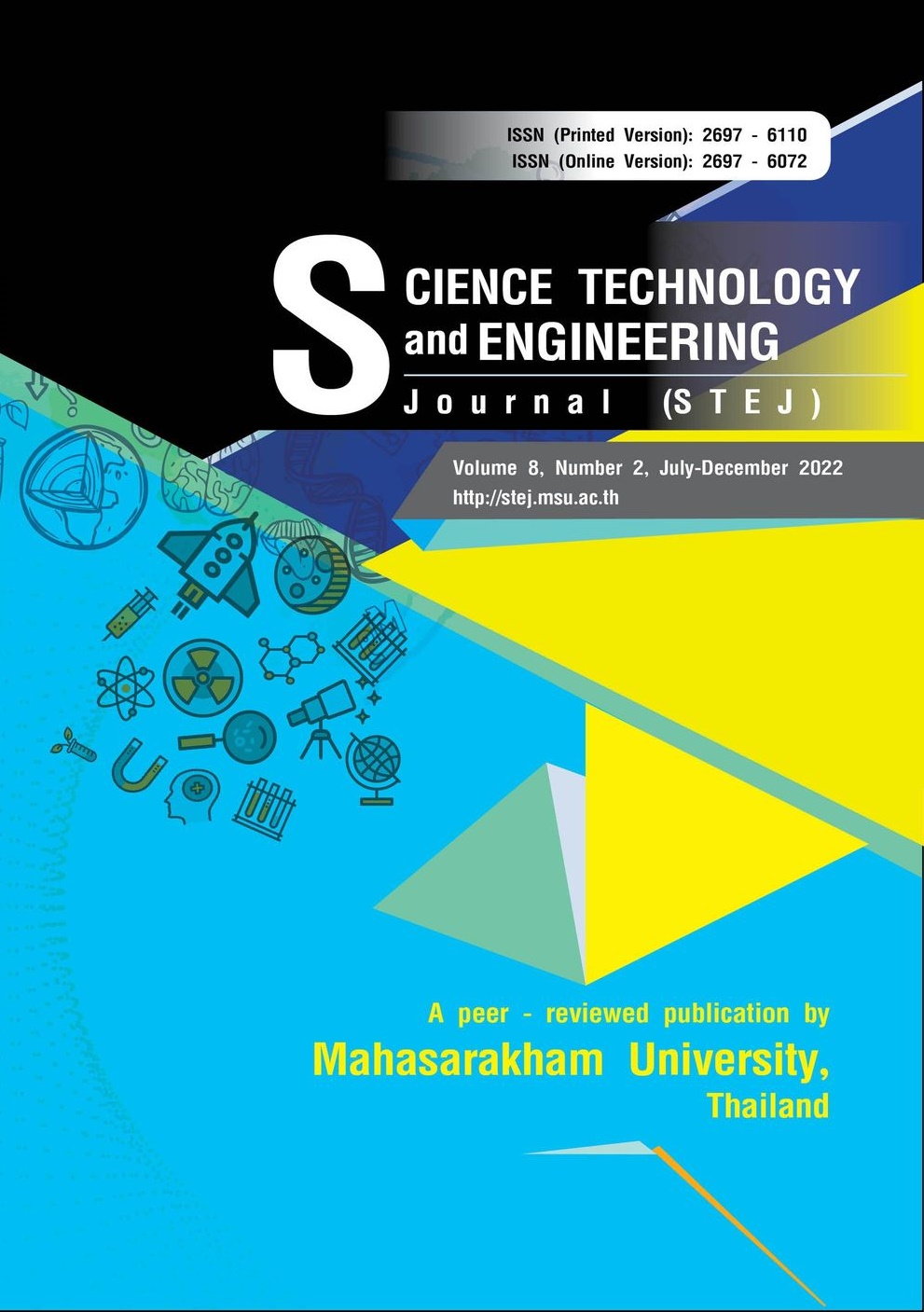Karyological analysis of ten freshwater fish species from Lumphachi river basin, Thailand
Keywords:
freshwater fishes, chromosome, karyotypeAbstract
This research aims to study karyotype of ten species of freshwater fishes from Lumphachi river basin, Suan Phueng district, Ratchaburi province. Chromosomes were prepared directly from kidney tissue of each fish species (ten individual/species) and were then stained by conventional staining technique (Giemsa’s stain). The karyotype results of all ten fish species were shown as followed: Clown featherback (Chitala ornata) (2n = 42; NF = 44; 2a+40t), Striped tiger leaffish (Pristolepis fasciatus) (2n = 48; NF = 48; 48t), Three spot gourami (Trichopodus trichopterus) (2n = 46; NF = 46; 46t), Silver barb (Barbonymus gonionotus) (2n = 50; NF = 78; 6m+16sm+6a+22t), Red tailed tinfoil (Barbonymus altus) (2n = 50; NF = 86; 12m+20sm+4a+14t), Tire track eel (Mastacembelus favus) (2n = 48; NF = 68; 10m+6sm+4a+28t), Black sharkminnow (Labeo chrysophekadion) (2n = 50; NF = 86; 10m+8sm+18a+14t), Poropuntius melanogrammus (2n = 50; NF = 86; 10m+12sm+14a+14t), Hampala barb (Hampala macrolepidota) (2n = 50; NF = 86; 6m+18sm+12a+14t), and Roho labeo (Labeo rohita) (2n = 50; NF = 80; 8m+14sm+8a+20t), respectively. No sex chromosome differences were found in all fish karyotypes. Based on the data, this is the first report of cytogenetic study of fish species in this area. The information obtained can be used to support the taxonomic classification of freshwater fishes, manipulated for conservation of genetic resources of fishes in nature, and can be useful to understanding of chromosomal evolution of freshwater fishes in the future. Moreover, this finding can be used as a basis for genetic resources conservation and chromosomal evolution among fishes in the future.
References
Bertollo, L.A.C., Oliveira, C., Molina, W.F., Margarido, V.P., Fontes, M.S.M., Pastori, C., Falcão, J.N. & Fenocchio, A.S. (2004). Chromosome evolution in the erythrinid fish, Erythrinus erythrinus (Teleostei: Characiformes). Heredity, 93, 228-233.
Brum, M.J.I. & Galetti, P.M. Jr. (1997). Teleostei ground plan karyotype. J Comp Biol, 2, 91-102.
Chaiyasut, K. ( 1989) . Cytogenetics and Cytotaxonomy of the Family Zephyranthes. Chulalongkorn University.
Donsakul, T. & Magtoon, W. (1989). A chromosome study of Mastacembelid Fish, Mastacembelus favus and Mastacembelus erythrs taenia in Thailand. Srinakharinwirot University.
Donsakul, T. & Magtoon, W. (1990). A chromosome study on three species of featherbacks, Notopterus chitala (Hamilton), N. blanci (D’Aubenton) and N. notopterus (Pallas), from Thailand. Srinakharinwirot University.
Donsakul, T. & Magtoon, W. (1997). A chromosome study of five species of cyprinid fishes, Cirrhina microlepis, Leptobarbus hoevenii, Labiobarbus spiropleura, Barbodes schwanenfeldii and Barbodes gonionotus from Thailand. Srinakharinwirot Science Journal, 2, 30-42.
Donsakul, T. & Magtoon, W. (2002). Karyotypes of two cyprinid fishes, Hypsibarbus wetmorei and Morulius chrysophekadion, from Thailand. Proceedings of the 28th Congress on Science and Technology of Thailand (pp. 92). Queen Sirikit National Convention Centre, Bangkok.
Donsakul, T. & Poopityastaporn, A. (2002). Karyotype of fifteen species of cyprinid fishes (Family Cyprinidae from Thailand. Srinakharinwirot University.
Getlekha, N., Molina, W.F., Cioffi, M.B., Yano, C.F., Maneechot, N., Bertollo, L.A.C., Supiwong, W. & Tanomtong, A. (2016a). Repetitive DNAs highlight the role of chromosomal fusions in the karyotype evolution of Dascyllus species (Pomacentridae, Perciformes). Genetica, 144, 203-211.
Getlekha, N., Cioffi, M.B., Yano, C.F., Maneechot, N., Bertollo, L.A.C., Supiwong, W., Tanomtong, A. & Molina, W.F. (2016b). Chromosome mapping of repetitive DNAs in sergeant major fishes (Abudefdufinae, Pomacentridae): a general view on the chromosomal conservatism of the genus. Genetica, 144, 567-576.
Khuda-Bukhsh, A.R. & Das, J.K. (2007). Cytogenetic analyses in eight species of teleostean fishes (Pisces): karyotypes, multiple Ag-NORs, sex chromosomes. Research and Reviews in Biosciences (India), 1, 47-52.
Magtoon, W. & Arai, R. (1989). Karyotypes of five Puntius species and one Cyclocheilichtltys spe- cies (Pisces, Cyprinidae) from Thailand. Bulletin of the National Science Museum, Tokyo. Series A (Zoology), 15(3), 167-175.
Magtoon, W. & Donsakul, T. (1993). A chromosome study on three Cyprinid fishes, Labeo erythru- rus, L. bicolor and L. rohita. Proceedings of 31st Kasetsart University Annual Conference: Animal, Fisheries and Veterinary Medicine (pp. 543-551). Kasetsart University.
Piyapong, C. (1999). Karyotypes and distribution of nucleolus organizer regions in four cyprinid species from Thailand. Chulalongkorn University.
Rainboth, W.J. (1996). Fishes of the Cambodian Mekong. FAO species identification field guide for fishery purposes. Food and Agriculture Organization of the United Nations, Rome.
Sarasan, T., Donbundit, N.,Tanomtong, A., Supiwong, W. & Srisamoot, N. (2019). Cytogenetic analysis of Black Shark Minnow, Labeo chrysophekadion (Bleeker, 1850) (Cypriniformes: Cyprinidae) in Thailand. In : The First International Conference of Kalasin University 2019 (pp. 789-789).
Seetapan, K. (2007). Karyotypes of sex fish species of the family Cyprinidae. Proceedings of the 45th Kasetsart University Annual Conference: Fisheries (pp. 749-758). Kasetsart University.
Supiwong, W., Tanomtong, A., Kenthao, A., Seetapan, K., Kaewsri, S. & Sanoamuang, L. (2010). Standardized karyotype of the three-spot gourami, Trichogaster trichopterus (Perciformes, Belontidae) from Thailand by conventional and Ag-NOR staining technique. Nucleus (India), 53(3), 103-107.
Supiwong, W., Tanomtong, A., Khakhong, S., Silawong, K., Aoki, S. & Sanoamuang, L. (2012). The First Chromosomal Characteristics of Nucleolar Organizer Regions and Karyological Analysis of Clown Knife Fish, Chitala ornata (Osteoglossiformes, Notopteridae) by T-Lymphocyte Cell Culture. Cytologia, 77(3), 393-399.
Swaminathan, T.R., Basheer, V.S., Gopalakrishnana, A., Rathore, G., Chaudhary, D.K.,Kumar, R. & Jena, J.K. (2013). Establishment of caudal fin cell lines from tropical ornamental fishes Puntius fasciatus and Pristolepis fasciata endemic to the Western Ghats of India. Acta Tropica, 128(3), 536-541. doi: 10.1016/j.actatropica.2013.07.020.
Downloads
Published
How to Cite
Issue
Section
License
Copyright (c) 2022 Science Technology and Engineering Journal (STEJ)

This work is licensed under a Creative Commons Attribution-NoDerivatives 4.0 International License.








